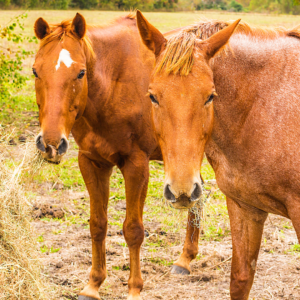 Risk Factors for Squamous vs. Glandular Ulcers in Horses. Despite being grouped together under the umbrella term “equine gastric ulcer syndrome,” one group of veterinary researchers* recently suggested that equine glandular gastric disease (EGGD) should actually be considered a distinct entity from equine squamous gastric disease (ESGD). This recommendation comes in the wake of their findings that different management and risk factors contribute to the two types of ulcers.
Risk Factors for Squamous vs. Glandular Ulcers in Horses. Despite being grouped together under the umbrella term “equine gastric ulcer syndrome,” one group of veterinary researchers* recently suggested that equine glandular gastric disease (EGGD) should actually be considered a distinct entity from equine squamous gastric disease (ESGD). This recommendation comes in the wake of their findings that different management and risk factors contribute to the two types of ulcers.
“Considering how prevalent EGGD has become, remarkably few data regarding risk factors and optimal management strategies, including feeding programs, have been designed for horses with this condition,” noted Laura Petroski-Rose, B.V.M.S., a Kentucky Equine Research veterinarian.
Squarmous vs. Glandular: Differences
Unlike squamous ulcers caused by the physical splashing of harsh stomach acids on the “higher” regions of the stomach lining, causes for ulcers in the glandular region remain unclear. One theory is simple failure of normal defense mechanisms, while another includes excess nonsteroidal anti-inflammatory drug administration. Unlike in humans and other mammalian species, Heliocobacter spp. do not appear to play a role in EGGD.
To gain a foothold on this important, performance-limiting welfare and health issue, Benjamin Sykes, an internist and adjunct associate professor at The University of Queensland, together with his colleagues from the United Kingdom and Australia, set to work. The team examined and collected management data (feeding, exercise, overall health.) They compared 109 Thoroughbreds training in eight different facilities in the U.K. and Australia. They found:
- Horses with EGGD vs. ESGD had different management factors and clinical signs of disease, as suspected;
- Exercising >5 times per week was associated with a tenfold increased risk of EGGD;
- Poor performance, or performing below expectation, was associated with an almost fourfold increased risk of EGGD;
- Horses with stereotypies were more likely to have ESGD. However, ironically, horses displaying aggression towards humans were less likely to have ESGD; and
- Individual trainer was also identified as a risk factor for EGGD.
“Indeed, these two conditions appear distinct and must therefore be managed as such. Without clear knowledge of the underlying processes contributing to EGGD development, outlining the best strategies to approach horses with EGGD remains challenging,” summarized Petroski-Rose.
That said, stress does appear to play a role in EGGD. Therefore, further exploration of stress pathways and cortisol are warranted.
Potential Management:
“Without clear insight into the underlying pathways, management of any gastric ulcer relies heavily on forage-based diets including alfalfa hay, using slow-feeders so that the horse can consume forage for most hours throughout the day, and minimizing dietary concentrates,” advised Petroski-Rose.
Contact a Kentucky Equine Research nutrition advisor once your veterinarian has confirmed the presence of gastric ulcers. Be sure to ask about RiteTrac—a supplement designed to quickly neutralize excessive gastric acid, thereby protecting the stomach lining and restoring the normal gastric environment. Horse owners in Australia should look for these research-proven products.
*Sykes, B.W., M. Bowen, J.L. Habershon-Butcher, M. Green, and G.D. Hallowell. 2019. Management factors and clinical implications of glandular and squamous gastric disease in horses. Journal of Veterinary Internal Medicine 33(1)233-240.
